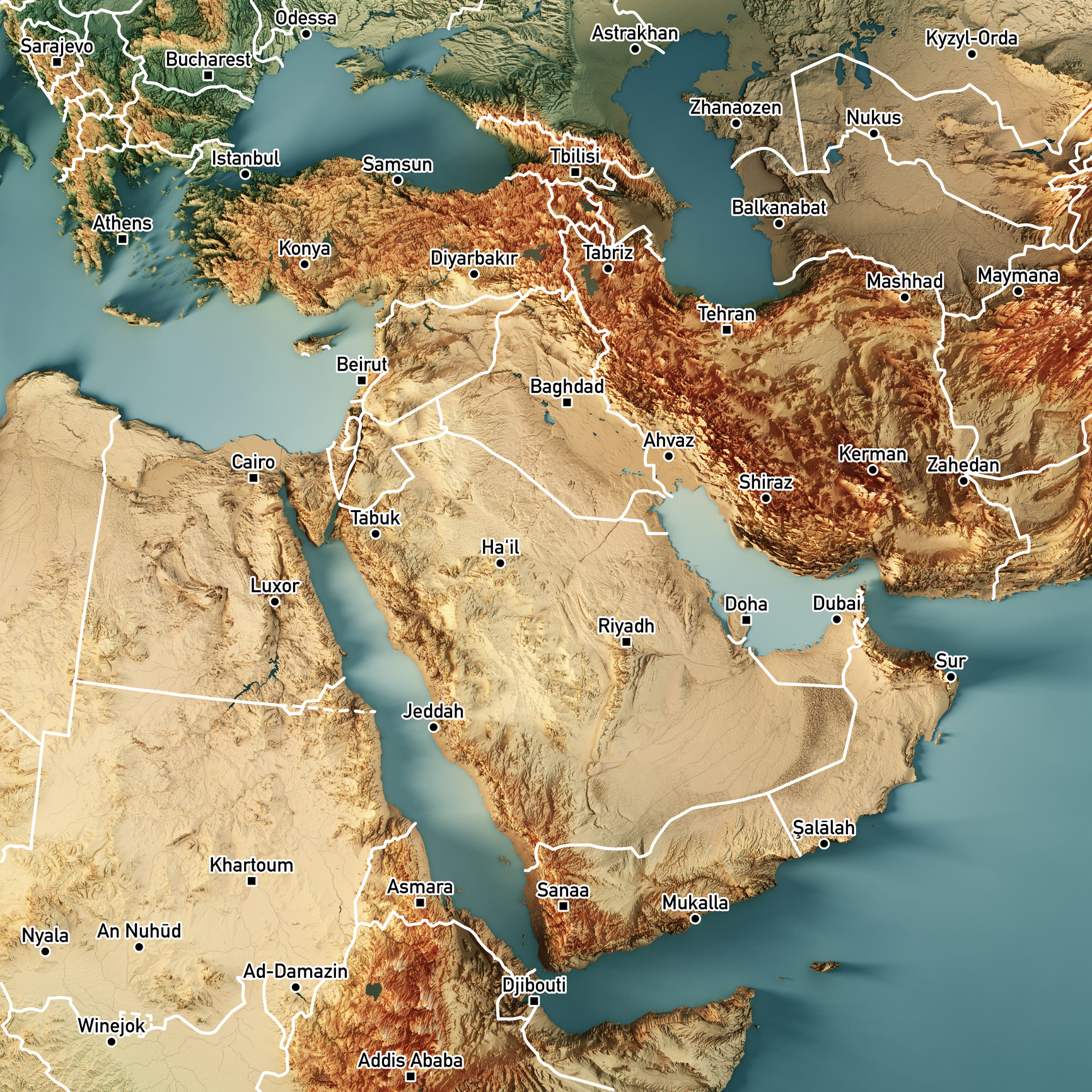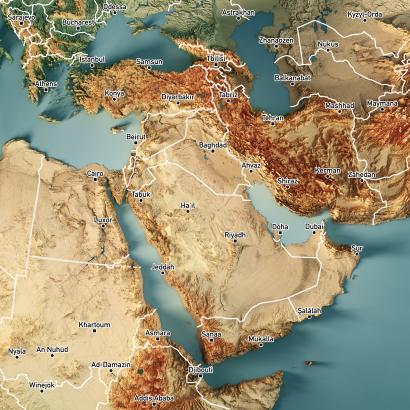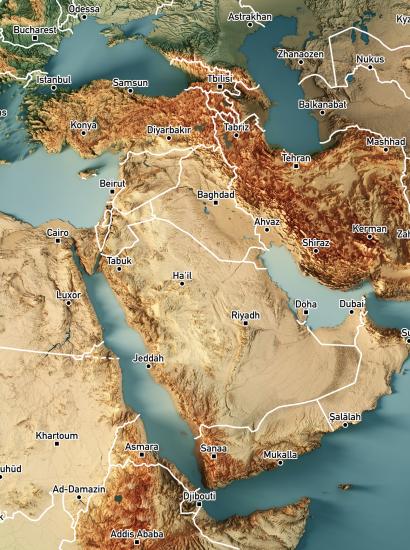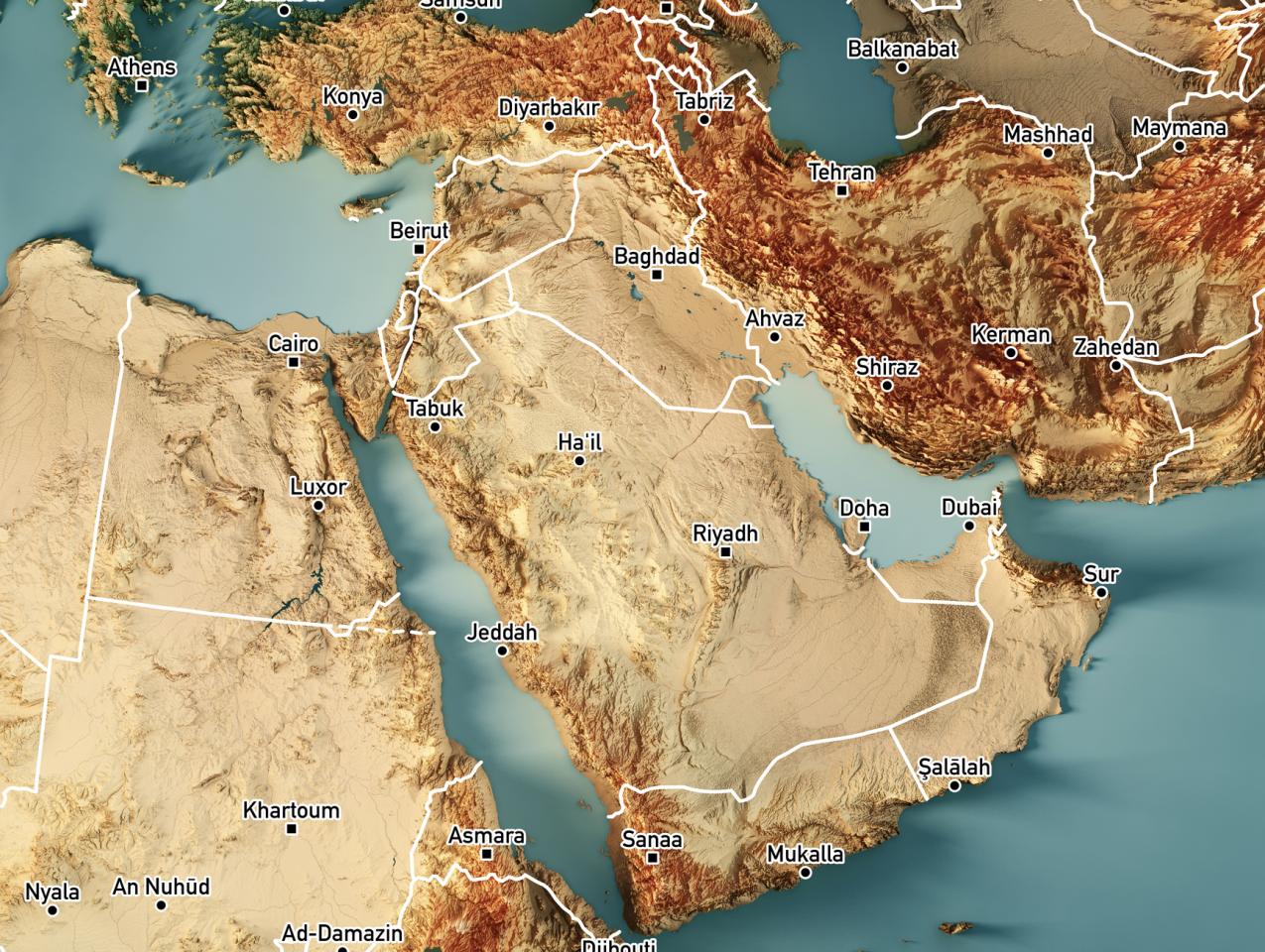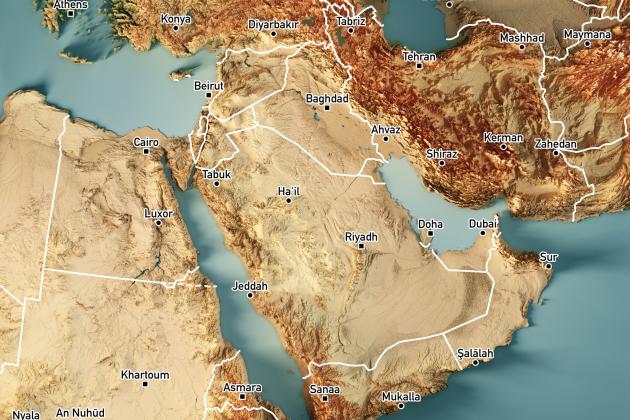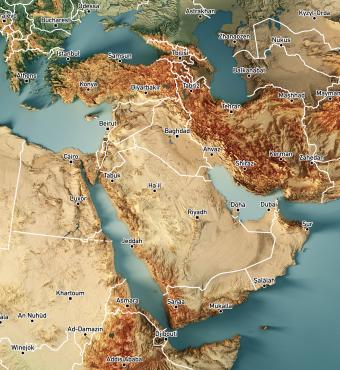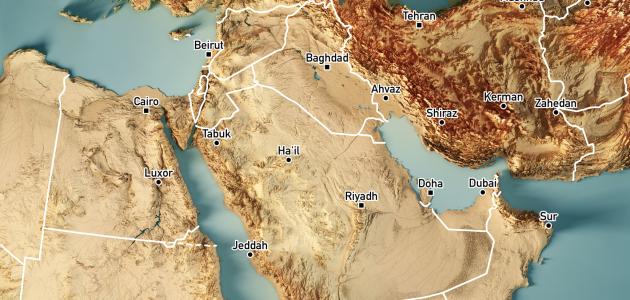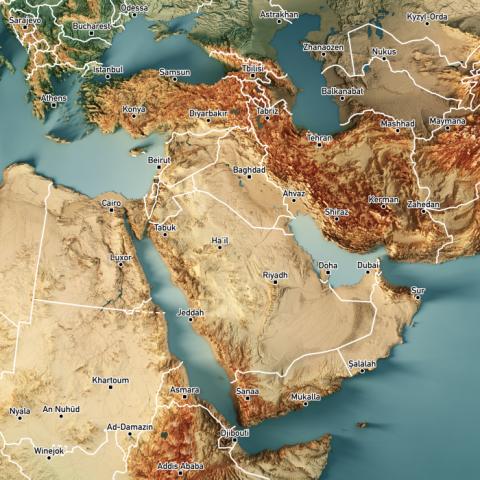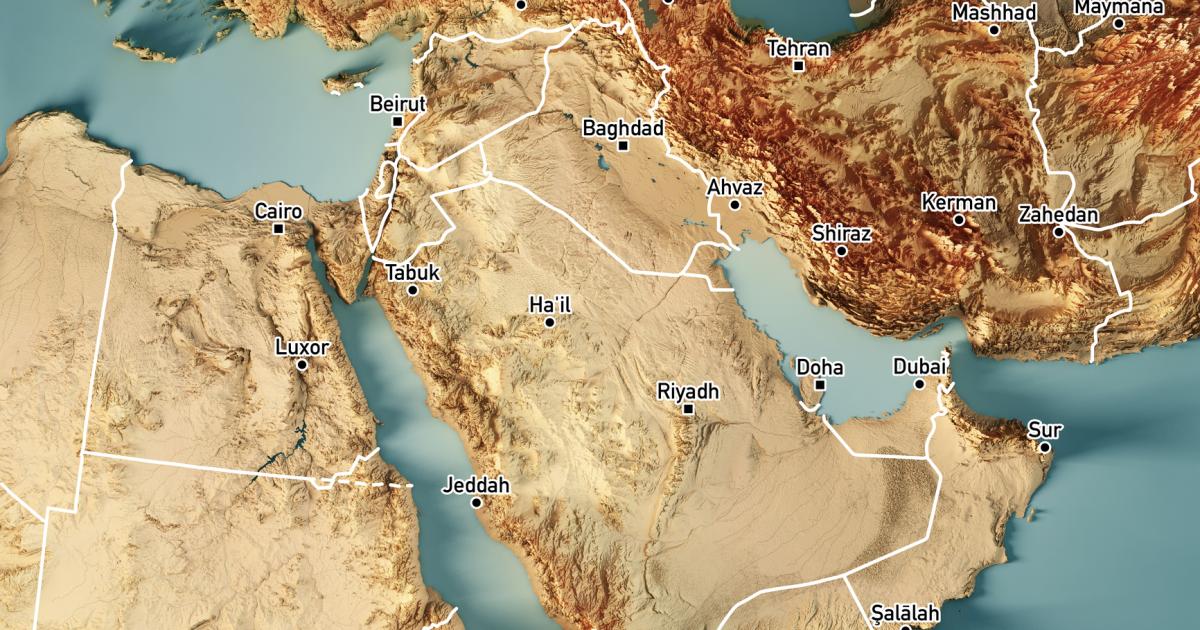- Middle East
- Determining America's Role in the World
Asia, Africa and Europe meet in the Middle East. The region has long been the crossroads of the world and the home of empires. Its importance will not wane. Yet the intersection of the three continents does not offer a simple geography. It is marked by inland seas bordered by often contested coastlines–the Sea of Azov, the Black Sea, the Red Sea, and of course the Mediterranean, with a name that declares it the center of the earth. To complicate matters, these bodies of water are constrained by strategic chokepoints: the Kerch Straits, the Bosporus and the Dardanelles in the north, and then moving southward: the entry to the Suez Canal, the Straits of Tiran, Bab-el-Mandeb and the Straits of Hormuz. Far to the west, Gibraltar belongs on the list.
World commerce flows through these narrow passageways, including the still vital oil exports from the Gulf States. This trade remains perpetually vulnerable to hostile forces at the chokepoints, as we see now with the attacks by the Houthis from Yemen. Disruption of commerce through the maritime Middle East has the potential to destabilize economies as distant as the Far East as well as Europe. Nor would the United States be immune to the economic consequences of commercial blockades or impediments to the follow of oil. Freedom of navigation in the region is vital to American security, and at this point, only the U.S. can guarantee it.
This large expanse from the Black Sea to Indian Ocean therefore retains great strategic significance, especially in the current era of great power competition. Any misguided policy inclination for the U.S to give up on the region, to withdraw from the Middle East and to “pivot” to China would be a disaster for American security. Power abhors a vacuum; any American departure would hand the region over to our adversaries.
Currently the U.S. remains the dominant great power in the region. Our adversaries are not even close. Russia has seen its foothold in Syria significantly reduced, in the wake of the fall of the Assad regime, while China has been cautious to enter the region, except as an economic power through the Belt and Road initiative and its predatory investments in Africa. On the chessboard of global power strategy, it is therefore the U.S. alone and neither of the near peer competitors that holds preeminence in the region.
Yet that preeminence is not without costs. The Middle East remains fraught with too many conflicts to list them all, but they include: the civil war in Sudan, the terrorism of the Houthis in Yemen, the war in Gaza and the Palestine question, the arc of instability across the Levant–Lebanon, Syria, Iraq–and of course the ominous threat of a nuclear Iran. To the extent that an external power is called upon to address them, it is only the U.S. that can play that role. Hence in the various recent diplomatic initiatives, it is only Washington that counts. The Europeans have largely been sidelined. The “Quartet” two decades ago, which brought together the U.N., the E.U., Russia and the U.S. to address the conflict between Israel and the Palestinians seems like ancient history. Only American leadership matters now. So much for the chatter about declining U.S. power.
Each of the several conflicts listed above has its own local particularities. Some of them have been discussed in previous issues of the Caravan. However, it is vital not to lose sight of the forest for the trees and to keep in mind the larger strategic challenges facing U.S. policy in the maritime Middle East, especially the following five points.
First and foremost, it is up to the U.S. to maintain freedom of navigation in an area vital to the world economy. Such has been the American role in the region since the suppression of Barbary Coast piracy and boots on the ground on the “shores of Tripoli.” Today this mission includes maintaining chokepoint security and denying adversarial actors the capacity to block the trade flows and commerce in energy at locations like the Straits of Hormuz and Bab-el-Mandeb. It also defines a key component of the strategic relationship with NATO partner Turkey which commands the pathway between the Black Sea and the Aegean. Currently the Iran-backed Houthis threaten shipping with missile and drone attacks. As a result, maritime security has been eroded, forcing vessels to find alternative and lengthier routes from Asia to Europe, thereby contributing to a rise in prices. The U.S. has the naval presence to respond to the Houthis, especially with the Fifth Fleet in Bahrain, but resources are stretched thin. The ceasefire of May 6 promises protection to U.S. ships alone, meaning that the Houthis will continue their disruption. This is an unstable pause at best. Continued conflict is likely.
Second, Iran is not merely a local problem, a human rights question involving the regime’s suppression of domestic opposition, when the Iranian people try to assert their rights. In addition, the Islamic Republic has long been pursuing a strategy of regional destabilization, framed in terms of its foundational revolutionary ideology. As a response to the traumatic impact of the threat to the homeland experienced during the war with Iraq, Iran prefers to keep the fighting far from its own borders by relying on proxies, politically aligned military forces in an array of theaters: Hezbollah in Lebanon, Hamas in Gaza, Shia militia in Iraq and the aforementioned Houthis in Yemen. Hence the characterization of Iranian policy as the will to fight to the last Arab in distant theaters.
However, it remains up to Iran to defend its own coastlines, and it has therefore developed an asymmetric naval strategy. It relies on fast attack boats, drones and mines in order to exercise control on the sea and to harass American assets. For example, on January 12, 2016 two American training boats drifted inadvertently into Iranian waters. Ten American sailors were captured by the Iranian Revolutionary Guard Corps and detained for 15 hours. Humiliating photographs of the sailors kneeling with their hands behind their heads were circulated providing a propaganda coup for Tehran. Should the U.S. withdraw from the region, it is foreseeable that Iran would seize the opportunity to extend its naval presence in the Gulf and the Red Sea, with an increased likelihood of conflict with other regional actors. A naval expansion of Iranian power would furthermore have the impact of cutting off the Indo-Pacific from access to the Mediterranean through Suez. (That strategy of severing maritime links between Europe and India was a motivating factor in German strategy in both the world wars, an indication of the enduring geostrategic value of the Middle East.)
Third, despite the U.S. lead in the region, China and Russia remain potential threats. It must not be forgotten that they, together with Iran and North Korea, operate in concert to degrade American power. Their ultimate goal is to push the U.S. away from the Eurasian landmass. China projects power primarily through economic initiatives, but also through investments in port infrastructure which most certainly also have an intelligence gathering dimension. Yet there is also a hard military dimension: on April 19 of this year China and Egypt conducted joint military drills near the Israeli border, and in May they collaborated in aerial exercises with fighter jets. The Chinese People’s Liberation Army has been operating its first overseas military base in Djibouti near Bab-el-Mandeb. China is not the major military force in the region by any means, but it may be expanding its presence.
Meanwhile, as far as Russia is concerned, the fall of the Assad regime in Syria has constrained it but by no means terminated its presence. Its naval base at Tartus, built in the 1970s, is the sole Russian facility on the Mediterranean and therefore vital to Moscow’s power projection in the region. Russia also maintains an airbase nearby at Kheimim. Although Russia was a key pillar of support for Assad, the post-Assad Syrian leadership has chosen not to expel it, instead only recalibrating the relationship. Russia still remains present in Syria albeit with a reduced footprint. As President Trump opens relations with post-Assad Damascus, a plausible goal of U.S. diplomacy could include full termination of Russian presence. Removing Russia from Syria would severely curtail Moscow’s efforts to operate in the Mediterranean and in Africa where–especially in the Sahel–it has made progress in recent years.
Fourth, a lack of internal political cohesion has emerged across the region. The UAE, Saudi Arabia and Qatar all pursue independent and often competing courses. Instead of a united Arab bloc, one faces a regional multipolarity. Trump’s apparently strong relationship with the Saudi Crown Prince may tilt the balance toward Riyadh, but the constellation of interests remains unstable. A similar complexity defines the non-Arab powers: Israel, Iran and Turkey, caught up in their own competitions. The Arab states are rightly fearful of Iran and its imperial ambitions. At the same time, they are, to varying degrees, uncomfortable with Israel’s prosecution of the Gaza War. As of this writing, it remains to be seen if Trump’s visit to the region can have an effect on these internal tensions and reassert American leadership in a way that produces greater regional cohesion. This is not a specifically maritime challenge, although U.S. naval power, especially as a deterrent to Iran, will remain key to any security calculation that would underpin a political agenda.
Fifth and finally, there is a set of distinctly maritime challenges, including infrastructure vulnerabilities, especially concerning port facilities, undersea cables and oil pipelines. Hostile states or non-state actors have opportunities to wreak havoc; for example, it is reasonable to assume that Iran would hit Saudi facilities, if Israel or the U.S. were to attack its nuclear sites. Similarly Israeli gas operations in the Mediterranean are exposed targets. Maritime systems in general are uniquely vulnerable to cyber-attacks, drone attacks or untraceable sabotage, as was seen in the damage to the Nord Stream 2 pipeline in the Baltic. In addition, there is a significant cost asymmetry between the very expensive vessels, the core of naval power, openly exposed on the surface of the ocean, and increasingly inexpensive drone and missile technology that adversaries can use to level the playing field. Especially in this era of budgetary limitations, lower costs quickly become a military advantage.
Despite the global scope of great power competition, the U.S. currently dominates in the Middle East. Neither Russia nor China commands any comparable influence, although both are present and fundamentally hostile to American preeminence. Therefore, the Middle East is very much an opportunity for the Trump administration to establish regional political cohesion by resolving the competition among the various states and solving the several conflicts. That is the substance of the program of the Abraham Accords. A withdrawal from the region would be foolish–whether motivated by isolationism or by an absolute prioritization of the China challenge. It is vital to keep the larger picture in mind of the maritime space that stretches from Gibraltar to the Black Sea and to the south to the Gulf and the Indo-Pacific. An American policy of economic integration grounded in freedom of navigation has the potential to bring stability, while sidelining adversaries and spoilers.







